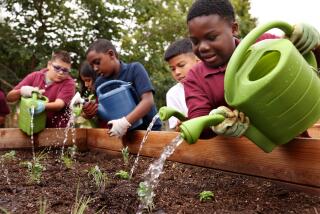Color, Beauty Inspire Students : Test Scores Improve After Campus Rejuvenation
BELL GARDENS — When Stephen E. Stanton looked around the 45-year-old Bell Gardens Intermediate School two years ago, he saw drab walls and a barren campus. He also saw students who ranked at the very bottom of the education heap, according to state tests.
Today, Stanton--the 39-year-old principal at the fifth- through eighth-grade school in the Montebello Unified School District--sees trees, greenery and bright walls at the school built by the Depression-era Works Progress Administration. He also sees students who care about their campus, and, he said, about themselves.
As a result, said Assistant Principal George Ristic, who has been at Bell Gardens Intermediate since 1961, students are performing better in the classroom.
Stanton calls it living up to the school motto, “Commitment to Excellence” (a slogan adopted even before the Raiders came to Los Angeles). And his 2-year-old beautification program is at the heart of an effort involving students, parents, teachers and community volunteers.
“The beautification efforts have a very positive effect on the learning environment,” Stanton said. “Kids take pride in the environment.”
Improved in All Categories
Bell Garden Intermediate’s sixth- and eighth-grade students, while still ranked low statewide, nevertheless improved last year in every California Assessment Program testing category--reading, writing and mathematics--over the previous school term.
The beautification efforts have paid off not only in academic improvement, but have won for the school the district Superintendent’s Award for beautification for the past two years, said Salvador Traslavina, assistant superintendent of pupil and community services.
Just outside the administration building, everything from a redwood tree to daisies are thriving. According to Stanton, the school, in partnership with the Los Angeles State and County Arboretum, has begun to turn the campus into a garden. The partnership came about in 1984 through the efforts of John Stillon, the art consultant for county schools, who was impressed with what was going on at Bell Gardens Intermediate.
In the past two years, the arboretum, Bill Park Nursery of Bell Gardens and a nursery that wants to remain anonymous have donated more than $10,000 in plants to the school.
Before the program, the school was practically barren, and it was filthy, Stanton said. Now, litter is rare and graffiti even rarer. As part of the beautification efforts, the maintenance crew arrives at 6:30 a.m. daily, removing any fresh graffiti before students arrive.
Auditorium Next
Next on the agenda is painting the auditorium. After the auditorium is painted, Stanton said, graphics will make it look like a movie palace of the past. He hopes to get help from the PTA to employ professional artist Susan Twitchel, who has worked previously in the school’s beautification program. As with other projects, students will play a key role. The rest of the school is to be painted before June.
Besides sprucing up the school’s exterior, the halls are being painted by teams of students who have been taught by Twitchel. In a building reserved for fifth-graders, the once-drab walls are now beige and blue with graphic designs around the doorways imitating 1940s architecture.
Paints and supplies worth $500 have been donated by a Standard Brands paint store in Downey, while Rainbow Paint Co. in Bell Gardens has chipped in with $200 worth of material. The painting has taken place mainly during lunch and after school. Also, the lockers have been ripped out and each of the nine classrooms has a bulletin board on which to display class accomplishments.
Virginia Espinoza, an instructional aide in English as a second language, said she has seen students’ attitudes change for the better with the beautification program. “It’s taught kids to respect their school,” she said.
The students not only enjoy the sights and smells of greenery, but it also gives them a place to relax.
“When it’s hot,” said seventh-grader Mike Espinoza, “everybody likes to hang out by the trees.”
Summer Relief
Stanton said that the year-round school calendar, which went into effect during the 1981-82 school year, made the beautification effort and the shade trees all the more important. “In the summer, it gets to be 95 degrees,” he said.
Recognizing the need for students to get relief from the heat and to support the beautification efforts, the PTA recently spent $4,000 to build a park area at the school, complete with round tables, rosebushes and trees.
In the winter, when the students are in need of shelter rather than shade, they flock to the cafeteria, where there is a 360-degree mural of the Arcadia arboretum, painted in the summer of 1984 by Fairfax High School art teacher Jim Nastasia, who was recruited by Stillon and commissioned by the Montebello Unified School District for $1,500.
Ristic said the program has dramatically changed the campus.
“I’ve seen it filthy as a pig. Now, it’s a different kind of school.”
Ristic attributed the changes not only to the school’s efforts but also to the change in the community. “In 1961, most of the kids were from families that were coming from Arkansas and Oklahoma and always moving on. Fifty percent of the kids that started in September would not be here in June. Now, the community is very stable.”
That stability, he stressed, has contributed to the betterment of the school. “I’ve never heard kids talk so much about college. Things are good and the credit is all ours,” Ristic said.
Stanton added: “The kids are taking us up on the offers to learn. Girls say, ‘I want to be a nurse,’ and I tell them, ‘Why don’t you be a doctor, instead?’ ”






